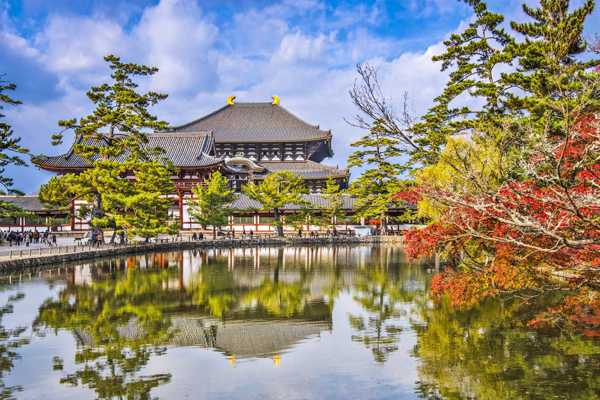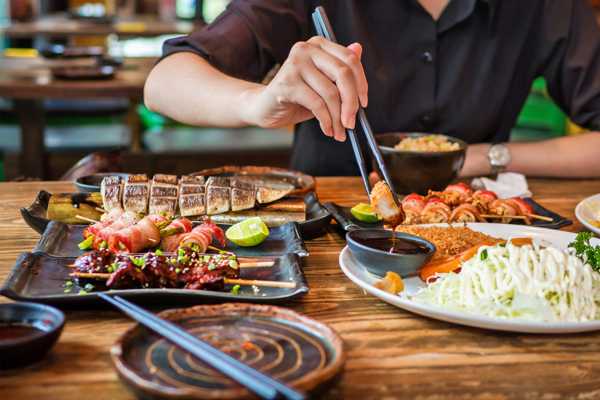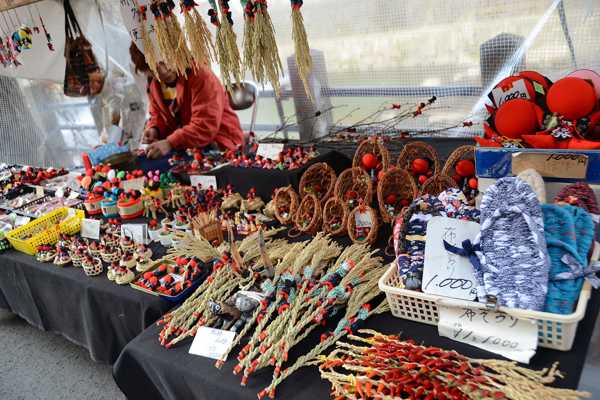With a rich history as the ancient capital of Japan, Nara has a unique food culture. While enjoying the local delicacies Nara has to offer, you can also take a trip through the history of Japan itself. Asuka Village's Asukanabe is a local dish that dates back to the Asuka period, about 1,300 years ago. Kakinohasushi (sushi in a Japanese persimmon leaf) developed as a unique example of the cuisine from Nara's inland areas.
Other unique dishes to try here include chagayu, which originates from a traditional event held at Todaiji Temple, and Nara noppe, a vegetarian dish.
- 1
Chagayu
The traditional morning dish of ancient Japan

- Makanan
Chagayu (tea porridge) is a traditional breakfast that has been loved by the people of Nara for over 1,200 years. It’s believed to originate from meals offered to monks at the Omizutori ritual performed at Todai-ji Temple.
Chagayu, made by boiling rice in simmered roasted green tea, has a moist and smooth texture. It’s easy to digest and doesn't sit heavy in your stomach. You can change its taste according to the season and your preference. It’ll warm your body on a cold winter’s day and cool you down on a hot summer’s day when you’re losing your appetite. Narazuke (pickles seasoned in sake lees) made by soaking shirouri (oriental pickling melon) in sake lees makes an ideal garnish for chagayu.
Lokasi: Nara Prefecture, Japan
Peta - 2
Asuka nabe
Discover traditional Japanese hot pot dishes

- Makanan
Asuka nabe is a unique hot pot dish made by adding milk to soup stock from chicken, which has been handed down as a local dish of Asuka Village in Nara Prefecture. It’s also said that this dish has a long history, originating with dairy products brought in by people who came to Japan from overseas during the Asuka period about 1,300 years ago.
Milk started to become popular in Japan during the Edo period, but in the area including Asuka Village, it became popular among nobles during the Asuka period, having been used for food since then. If you want to enjoy the mellow and creamy taste of Asuka nabe, winter is definitely the best season.
Lokasi: Asuka Village, Nara Prefecture, Japan
Petafoto oleh Yanagida Tetsuo (CC0 1.0) diubah suai
- 3
Inari-zushi
An ideal companion for cherry blossom and autumn leaf viewing

- Makanan
Inari-zushi, a kind of sushi that’s stuffed with vinegared rice containing chopped red ginger and sesame in fried sweet and spicy deep-fried tofu, is a portable food unique to Japan that makes for a handy snack whenever you’re a little hungry or on the move.
Nara Prefecture's various types of local sushi include kakinoha-zushi (sushi wrapped with a persimmon leaf), hoba-zushi (sushi wrapped with a magnolia leaf), mehari-zushi (rice ball wrapped in pickled leaf mustard), and inari-zushi (sushi rice inside deep-fried tofu). Inari-zushi can be enjoyed at udon restaurants as well as at sushi restaurants, since it’s popular as a side dish to accompany noodles.
Lokasi: Nara Prefecture, Japan
Peta - 4
Kakinoha-zushi
One of Nara's most celebrated dishes

- Makanan
Kakinoha-zushi is a type of oshizushi (pressed sushi) made by wrapping vinegared rice with salmon or mackerel fillets with a persimmon leaf, and this is one of Nara's most celebrated delicacies. In the Nara region, persimmon leaves, which contain tannin and have a bactericidal effect, have been used for food preservation since ancient times.
With its beautiful colour contrast between dark green persimmon leaves and white vinegared rice and great taste, kakinoha-zushi is one of the most famous delicacies the region has to offer. You can also find it sold as a takeaway dish perfect for lunch on a train or a picnic somewhere.
Lokasi: Nara Prefecture, Japan
Peta - 5
Manju
Nara is a shrine to the birthplace of manju dumplings

- Makanan
In the ancient capital of Nara, you’ll find many food cultures that have been carried down to the present, one of which is manju (a steamed yeast bun with filling), a Japanese confectionery for everyday eating.
Legend has it that Rin Join came to Japan from China in the 14th century and made something similar to a Chinese cake called manto by wrapping a bean paste with a dough made from kneaded flour, creating the first manju. Kango-jinja Shrine in Nara has in its precincts Rin-jinja Shrine, a shrine dedicated to Rin Join, and the Manju Festival is held here on April 19th every year.
Lokasi: 2-banchi Kangokucho, Nara City, Nara Prefecture 630-8242, Japan
Telefon: +81 (0)742-22-0612
Peta - 6
Miwa somen
Japan's birthplace of hand-pulled somen noodles

- Makanan
Miwa somen is famous as one of the three greatest examples of somen (Japanese noodles made from flour) in Japan, along with Banshu somen in Hyogo Prefecture and Shodo-shima somen in Kagawa Prefecture. It’s a delicacy of the Miwa region, which covers Sakurai City in Nara Prefecture, and its history goes back to the Nara period. According to legend, somen originated when descendants of the priest of Omiwa Shrine in the land of Miwa received a revelation that told them to make something to eat to prevent suffering from hunger.
Even now, many restaurants in Sakurai City offer variations of Miwa somen on their menu, such as nagashi somen (flowing somen noodles), nyumen (boiled somen noodles), and kamaage somen (plain hot somen noodles served with dipping sauce). These somen varieties are also great with kakinoha-zushi (sushi wrapped in a persimmon leaf).
Lokasi: Sakurai City, Nara Prefecture, Japan
Peta - 7
Nara-style noppei
Enjoy meat-free Nara-style noppei

- Makanan
Unlike noppei-jiru (noppei soup) that you’ll find in the Tohoku and Hokuriku regions of Japan, the Nara version is a simmered dish with little soup and is Buddhist cuisine that doesn’t contain any meat. You can make it by simmering root vegetables such as Japanese radish and satoimo (taro), deep-fried tofu, konnyaku, dried shiitake mushrooms, and other ingredients in lightly seasoned soup.
Also, people in Nara don't use potato starch to add thickness because the taro in the soup naturally becomes soft and gives its own thick texture. It’s customary to offer noppei-jiru to worshippers ahead of the Kasuga Wakamiya Onmatsuri Festival, Kasuga Taisha Shrine's annual festival marking the end of the year.
Lokasi: Nara Prefecture, Japan
Peta - 8
Kaki-namasu
Nara's traditional New Year's cuisine is enhanced with persimmon

- Makanan
Kaki-namasu (persimmon salad) is a New Year's dish with a gentle taste featuring the persimmons that bring the ancient city into beautiful colour during the autumn. In Nara Prefecture, kaki-namasu made by adding chopped dried persimmons to red and white namasu (a pickled salad made with shredded carrot and Japanese radish) has been eaten as a New Year’s dish since ancient times. People used dried persimmons as a substitute for sugar when it was still expensive, and that’s how kaki-namasu came to be.
On New Year’s Day or other celebratory occasions, it’s often served using a hollowed persimmon fruit as a serving dish. This simple local dish is still hugely popular today.
Lokasi: Nara Prefecture, Japan
Peta - 9
Kuzumochi
Experience the exquisite texture of this unique delicacy

- Makanan
Nara's kudzumochi is an elegant Japanese confectionery made from arrowroot that has been produced in the Yoshino area for as long as anyone can remember. Yoshino's hon-kudzu (arrowroot powder made from highest quality kudzu) is made by purifying the roots of kudzu, a climbing plant of the pea family, using groundwater when it’s very cold. This highest-quality starch is also used as an ingredient for kakkon-to, a Chinese herbal medicine.
Since it’s become difficult to obtain hon-kudzu, potato starch is currently used in most kudzumochi on the market, so if you visit Nara, be sure to try the authentic kudzumochi. At Nakai Shunpudo, a kudzu specialist in front of Yoshinoyama Zao-do, you can taste unique kudzumochi and kudzukiri (kudzu starch noodles) that you won't find anywhere else. But be quick! You have only 10 minutes to eat it before its flavour is lost.
Lokasi: Nakai Shunpudo: 545 Yoshinoyama, Yoshino-cho, Yoshino District, Nara Prefecture 639-3115, Japan
Buka: Nakai Shunpudo: From 10 am to 5 pm. Closed on Wednesdays and 2nd and 4th Thursdays of the month (no holidays in April and November). Open only on Saturdays and Sundays in winter (open during the New Year holidays).
Telefon: +81 (0)746-32-3043
Peta - 10
Yamato-mana-no-nibitashi
A classic small dish made with traditional vegetables
- Makanan
Yamato-mana-no-nibitashi (deep-fried tofu with vegetables) is a local dish from Nara, made by quickly boiling Yamato-mana, otherwise known as tsukena, a traditional vegetable in Nara belonging to the brassica family, together with usuage (thin deep-fried tofu) in a soup flavoured with soy sauce. Its recipe is virtually identical to that of Kyoto’s mizuna-to-oage-no-taitan (potherb mustard and deep-fried tofu cooked in a pot), another popular Kansai side dish that uses vegetables.
The key to making it delicious is to turn off the heat early to stop the beautiful leaf colour and texture of the Yamato-mana from disappearing. If you want to taste Yamato-mana-no-nibitashi as a home-cooked dish, try one of the local restaurants in the Naramachi area.
Lokasi: Nara Prefecture, Japan
Peta


















